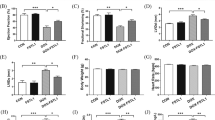Abstract
The aim of the present study was to evaluate the effects of quercetin-filled phosphatidylcholine liposomes (PCLs) on peroxynitrite (ONOO−)-induced cardiac arrhythmias. Experiments were done using different experimental models, including isolated rat papillary muscle, Langendorff perfused rat hearts, and anesthetized animals. Being exogenously applied in a concentration greater than 50 μM, ONOO−, caused inhibition of isometric twitch amplitude in isolated papillary muscles and led to an appearance of arrhythmias. Decomposed ONOO− had no similar effects and reversibly increased twitch amplitude. Authentic nitric oxide (NO, 100 μM) did not produce arrhythmias and had no significant effect on twitch amplitude. Verapamil and ruthenium red were with-out effect on ONOO−-induced arrhythmias, whereas tetrodotoxin and nicorandil effectively prevented arrhythmias development. Ouabain increased the arrhythmogenic effect of ONOO−. ONOO− significantly decreased coronary perfusion pressure (CPP) and mean left-ventricular pressure (MLVP) in the Langendorff perfused rat heart and produced severe arrhythmias. Authentic nitric oxide (NO) decreased CPP and MLVP insignificantly and resulted in a low incidence of arrhythmias. The NO donor SIN-1 in doses greater than 50 μM led to the appearance of low-incidence arrhythmias in anesthetized rats. Intraventricular injection of ONOO− promotes the appearance of a high incidence of arrhythmias in anesthetized rats and decreased MLVP. PCLs filled with the antioxidant quercetin restored normal cardiac contractility in both isolated tissues and anesthetizes animals. In conclusion, we hypothesized that ONOO−, but not its decomposed products, can initiate membrane lipid peroxidation and damage the phospholipid environment of ionic channels in myocardial cell plasma membranes inducing abnormal cardiac action potentials, arrhythmogenesis, and contractile dysfunction. Quercetin-filled PCL provide reliable protection against peroxynitrite-induced myocardial injury in isolated cardiac tissues and anesthetized animals primarily as a result of the decomposition of endogenously formed ONOO−.
Similar content being viewed by others
References
Aiello, E.A., Jabor, R.I., and Cole, W.C. (1995). Arrhythmia and delayed recovery of cardiac action potential during reperfusion after ischemia. Circ. Res. 77:153–162.
Corr, P.B. and Wikowski, F.X. (1983). Potential electrophysiologic mechanisms responsible for dysrhythmias associated with reperfusion of ischemic myocardium. Circulation 68(Suppl. 1):I-16–I-24.
Kelly, R.A., Balligand, J., and Smith, T.W. (1996). Nitric oxide and cardiac function. Circ. Res. 79:363–380.
Radi, R., Beckman, J.S., Bush, K.M., and Freeman, B.A. (1991). Peroxynitrite oxidation of sulfhydryls. J. Biol. Chem. 266:4244–4250.
Zhu, L., Gunn, C., and Beckman, J.S. (1992). Bacterial activity of peroxynitrite. Arch. Biochem. Biophys. 298:452–457.
Liu, S., Beckman, J.S., and Ku, D.D. (1994). Peroxynitrite, a product of superoxide and nitric oxide, produces coronary vasorelaxation in dogs. J. Pharmacol. Exp. Ther. 268: 1114–1121.
Sies, H. (1993). Strategies of antioxidant defense. Eur. J. Biochem. 215:213–219.
Beckman, J.S., Beckman, T.W., Chen, J., Marshall, P.A., and Freeman, B.A. (1990). Apparent hydroxyl radical production by peroxynitrite: implications for endothelial injury from nitric oxide and superoxide. Proc. Natl. Acad. Sci. USA 87:1620–1624.
Xie, Y.W., Kaminsky, P.M., and Wolin, M.S. (1998). Inhibition of rat cardiac muscle contraction and mitochondrial respiration by endogenous peroxynitrite formation during posthypoxic reoxygenation. Circ. Res. 82:891–897.
Matheis, G., Sherman, M.P., Buckberg, G.D., Haybron, D.M., Young, H.H., and Ignarro, L.J. (1992). Role of l-arginine-nitric oxide pathway in myocardial reoxygenation injury. Am. J. Physiol. 262 (Heart Circ. Physiol. 31):H616-H620.
Moro, M., Darley-Usmar, V., Goodwin, D., Read, N., Zamora-Pino, R., Feelish, M., et al. (1994). Paradoxal fate and biological action of peroxynitrite on human platelets. Proc. Natl. Acad. Sci. USA 91:6701–6706.
Radi, R., Rodrigues, M., Castro, L., and Telleri, R. (1994). Inhibition of mitochondrial electron transport by peroxynitrite. Arch. Biochem. Biophys. 308:89–95.
Packer, M.A. and Murphy, M.P. (1994). Peroxynitrite causes efflux from mitochondria which is prevented by Cyclosporin A. FEBS Lett. 345:237–240.
Bauer, M., Beckman, J.S., Bridges, R., and Matalon, S. (1992). Peroxynitrite inhibits sodium transport in rat colonic membrane vesicles. Biochem. Biophys. Acta 1104:84–87.
Chaniotis, D.I., Deliconstantinos, G., Lymberi, M., Poyatzi, A., Stavridis, J.C., and Molyvdas, P.A. (1997). Electrophysiological and mechanical properties of isolated rabbit heart papillary muscles and their correlation with nitric oxide and oxygen free radicals in hypovolemic shock blood plasma. Med. Sci. Res. 25:777–782.
Mast, F. and Elzinga, G. (1990). Oxidative and glycolitic ATP formation of rabbit papillary muscle in oxygen and nitrogen. Am. J. Physiol. 258 (Heart Circ. Physiol. 27). H1144-H1150.
Nossuli, T., Hayward, R., Jensen, D., Scalia, R., and Lefer, A. (1998). Mechanisms of cardioprotection by peroxynitrite in myocardial ischemia and reperfusion injury. Am. J. Physiol. 275 (Heart Circ. Physiol. 2):H509-H519.
Stefanov, A., Khromov, A., and Zhukova, A. (1992). The prevention of postishemic myocardial injures by liposomes. Bull. Exp. Biol. Med. 113:590–593.
Author information
Authors and Affiliations
Corresponding author
Rights and permissions
About this article
Cite this article
Soloviev, A., Stefanov, A., Parshikov, A. et al. Arrhythmogenic peroxynitrite-induced alterations in mammalian heart contractility and its prevention with quercetin-filled liposomes. Cardiovasc Toxicol 2, 129–139 (2002). https://doi.org/10.1385/CT:2:2:129
Issue Date:
DOI: https://doi.org/10.1385/CT:2:2:129




